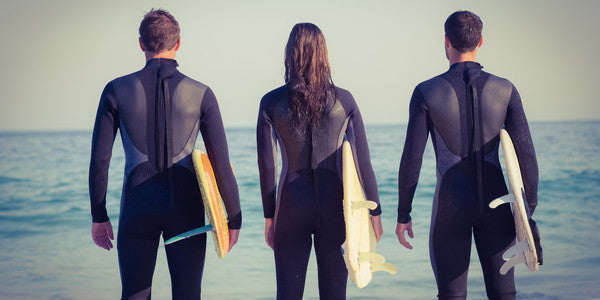Cart Details Should Go Here

Photo Credit - The Watch Judge
San Diego is perfect for surfing and ocean swimming alike. From the long beaches of North County to the renowned swim spot La Jolla Cove, there are waves out there for all of us. However, our water is cold which means wetsuits are a must! But wetsuits are made for swimming or surfing but not both. Below we explain the differences between swimming and surfing wetsuits and what happens if you surf in a swim wetsuit and vice versa.
Differences Between Surfing and Swimming Wetsuits
Thickness
Paddling out and sitting on a board in cold water necessitates a wetsuit. Surfing wetsuits help surfers stay warm by using differing thicknesses of neoprene for corresponding temperatures of water. For open water swimmers, temperature is less of an importance as they are constantly moving and have a high body temperature. Swimming wetsuits often have multiple panels of varying thickness. Swimming wetsuits have very thin layers in the armpits to allow for continual rotation. Sometimes the cuffs and sleeves of the arms and legs are designed for easy removal since triathletes need to be able to take of wetsuits as quickly as possible during transitions.
Speed
Open water swimming is all about speed, and swimming wetsuits are designed for optimal hydrodynamics. Swimming wetsuits have thicker neoprene over the hips so the body lies higher in the water, reducing drag. Another way swimming wetsuits reduce drag is often by being made from smooth skin neoprene which is a much smoother finish than thicker neoprene used in wetsuits. Beware of surfing in a swimming wetsuit because it's not meant to have a wide stance like on a surfboard!
Styles
Surfing wetsuits come in a wide variety of styles to fit differences in water temperature, from full length to vests. Swimming wetsuits are usually full suits or sleeveless, again to help create buoyancy and reduce drag. Wetsuits aren’t only for wearing in the ocean. If looking to stay warm in a pool for swimming or water aerobics, we recommend trying our wetsuit jackets, vests or springsuits. Note of caution: while rashguards are great for surfing, they’re not always a great choice for swimming. Make sure your rashguard fits tightly to avoid chafing when swimming for extended periods of time.
Similarities Between Surfing and Swimming Wetsuits
Care for wetsuit
No matter what type of wetsuit you have, the care is the same. Rinse the wetsuit inside and out with fresh water and hang to dry but avoid direct sunlight. Although the wetsuit can fade from wearing a wetsuit in a chlorinated pool, if thoroughly rinsed with fresh water after use the neoprene will hold up to the chlorine.
Suits vary in price
Manufacturers of wetsuits will produce wetsuits at different price points. Before spending a ton of money on the top of the line wetsuit, learn about the different features and technology used to see if it’s what you need. Try them on before buying to make sure the fit is good, nothing is worse than feeling a ballooning in the arms of of a too-big wetsuit, or trying to zip a too-tight wetsuit.
Suits differ in fit by company
When trying on wetsuits, put on wetsuits made by different brands. Each brand will have slightly different cuts and because a wetsuit needs to fit snug, it's worth finding the cut that fits your shape.
Try Before You Buy
Remember to find the right suit for the activity you are doing, whether it’s surfing or a triathlon and make sure it fits well. We sell many different surfing wetsuits for men, women and children. Our staff is trained to help determine which wetsuit is best for you and find the right fit!